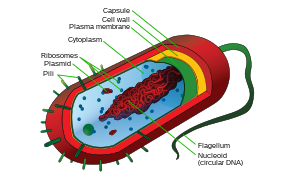Re: Actually, Caprylic problems
The experiment was done with the isolated caprylic acid. I wish he would have experimented with coconut oil. Ive never heard of coconut oil affecting friendly bacteria, but would like to do more research on it.† The lipase enzyme might interefere with the cell wall of friendly bacteria if our flora cell wall is made of† lipids.
Bacterial cell walls

Diagram of a typical
gram-negative bacterium, with the thin cell wall sandwiched between the red outer membrane and the thin green plasma membrane

Schematic of typical
gram-positive cell wall showing arrangement of N-Acetylglucosamine and N-Acetlymuramic acid
Around the outside of the cell membrane is the bacterial cell wall. Bacterial cell walls are made of peptidoglycan (also called murein), which is made from polysaccharide chains cross-linked by unusual peptides containing D-amino acids.[13] Bacterial cell walls are different from the cell walls of plants and fungi which are made of cellulose and chitin, respectively.[14] The cell wall of bacteria is also distinct from that of Archaea, which do not contain peptidoglycan. The cell wall is essential to the survival of many bacteria, although L-form bacteria can be produced in the laboratory that lack a cell wall.[15] The antibiotic penicillin is able to kill bacteria by preventing the cross-linking of peptidoglycan and this causes the cell wall to weaken and lyse.[14] The lysozyme enzyme can also damage bacterial cell walls.
There are broadly speaking two different types of cell wall in bacteria, called Gram-positive and Gram-negative. The names originate from the reaction of cells to the Gram stain, a test long-employed for the classification of bacterial species.[16]
Gram-positive bacteria possess a thick cell wall containing many layers of peptidoglycan and teichoic acids. In contrast, Gram-negative bacteria have a relatively thin cell wall consisting of a few layers of peptidoglycan surrounded by a second lipid membrane containing lipopolysaccharides and lipoproteins. Most bacteria have the Gram-negative cell wall and only the Firmicutes and Actinobacteria (previously known as the low G+C and high G+C Gram-positive bacteria, respectively) have the alternative Gram-positive arrangement.[17] These differences in structure can produce differences in antibiotic susceptibility, for instance vancomycin can kill only Gram-positive bacteria and is ineffective against Gram-negative pathogens, such as Haemophilus influenzae or Pseudomonas aeruginosa.[18]
Interesting post:
The lipid bilayer found in the fungal cell wall is critical for cell viability and pathogenicity. The lipid-coated fungi and other microorganisms are dependent on host lipids for their lipid constituents. This means that take them in from their surrounding environment. Disruption of the cell wall matrix results in a structurally-defective cell wall, rendering the fungal/yeast cell sensitive to osmotic lysis, macrophages, neutrophils, etc. Candida's lipid bilayer contains ergosterols that give it its strength. Undecenoic acid takes the place of the ergosterol and renders the fungal wall weaker and in more of a crystaline structure that is more fragile.
Once the conversion has taken place, the weakened cell wall memebrane of the yeast cell is vulnerable to the immune system. The other supplement would be fine to take, although I would be a little concerned about the possible effect of caprylic acid.
Wyss et al demonstrated more than 50 years ago that the greater the number of carbon atoms in the fatty acid chain, the greater the fungicidal activity, up to the point exceeding eleven carbon atoms, where solubility becomes the limiting factor. Undecenoic acid is an 11-carbon fatty acid. Caprylic contains 10 carbons and Lauric acid contains 12. Both have antifungal activity. Caprylic acid has toxicity associated with it. Lauric acid is a better anti-viral than an antifungal.





